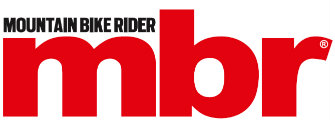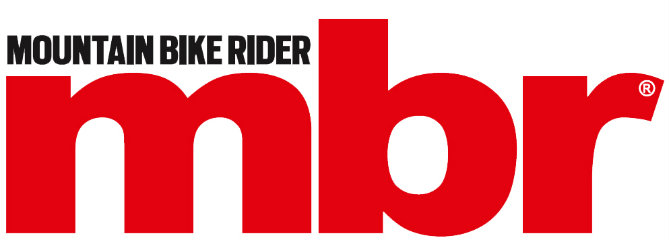Race Face's Era bar has a new, trendy 55mm high rise option, is designed to damp down trail buzz and comes with a multitude of decal colours
The Race Face Era carbon bar is my pick for riders over 80kg, it’s well damped without being flexy, and has the perfect natural shape
The fashion for low or high bars swings to and fro as frequently as the trend for skinny or flared jeans, and right now we’re squarely in high bar country, thanks in part to the Dak Stack. Started by top World Cup DH racer Dakota Norton, Dak Stack refers to his bolt upright riding position, boosted by a monster high-rise bar specially made by sponsor Mondraker.
There’s more to it than just fashion though, taller riders will benefit from more rise, and together with the Dak Stack that’s convinced Race Face to make one of its own. The 55mm tall Era bar joins the brand’s existing Era line-up of extra compliant handlebars and is, by my calculations, currently the sole carbon hi-rise bar around. It’s also the only tall bar specially tuned for extra comfort and vibration damping too, and that puts it well on the way to becoming one of the best mountain bike handlebars going.

Race Face makes the Era carbon bar in up to 55mm rise, but I went for a lower 20mm option as I’m not the tallest of riders
Race Face Era need to know
- Era carbon bar comes in 10mm, 20mm, 40mm and now super-high 55mm options
- Tuned for comfort and vibration damping, with three lengths to avoid cutting and reducing flex
- Middle of the road 8° backsweep and 5° upsweep geometry
- Lifetime warranty
Mr Norton might be a bit of an outlier amongst other DH pros, but Race Face told us sales of its 40mm bars have already outstripped 20mm Eras in the last year. Public demand really is out there and stands to go even higher, it says. I’ve seen more riders – especially on e-bikes – using higher bars myself, so Race Face’s theory stacks up too. (sorry for the crummy joke.)

Race Face Era carbon bar at its full, lofty 55mm height
At 55mm stack the tall Era might not quite match Dak’s huge On/Off-branded 75mm risers, but then we wouldn’t expect there to be a market for bar quite so high.
Taller bars are definitely a thing though, Renthal recently launched a range with 50, 60 and even 70mm rise, and Burgtec’s Josh Bryceland bars have offered 50mm for a couple of years.
Why tall bars?
The main train of thought is that high rise bars maintain a more upright position on super steep DH tracks, so a rider’s weight doesn’t get tipped forward as much if there’s an impact. There’s also a more relaxed riding position for e-bikers and taller riders who don’t want to lean really far forwards.
Many pals well over six foot have already been running bars like Burgtec’s Ride Highs, but you need to bear in mind that it’s a balance between loading the front tyre enough to generate grip, and security. I’m not tall myself, but have used the Burgtecs myself to cure a super low front end on one test bike recently.
Massive bars won’t be for everyone and that goes for me too. On most bikes, after many years trial and error, I prefer a medium height bar. That’s somewhere between Sam Blenkinsop’s head-down Schladming 2008-winning flat bar, and Dak Norton’s current skiing-like upright set-up. That means I’m testing the 20mm Eras here, rather than the full-on 55mm high models.

Race Face makes specific lengths to get round the problem of increased stiffness that comes with a cut down bar
Design and specification
Regardless of height or width, all Era bars are tuned to have the same ride characteristics. This is particularly important because cutting 800mm bars narrower can have a dramatic effect on stiffness, with Race Face claiming some rival bars become as much as 24% stiffer if cut from 800mm down to 760mm.
Eras come in three widths to avoid a reduction in compliance. It targets reducing arm and hand fatigue with its special carbon lay-up and geometry. Having 760mm, 780mm and 800mm options is presumably more expensive, but also makes it much easier to get the right bar for your width preferences, without having to bust out the hacksaw.

The smaller clamping area isn’t really a problem unless you’re running the Era on a downhill bike
All Era bars feature a unidirectional carbon fibre layup with tailored internal and external shaping. A total of 96 different pieces of carbon make up the final shape, and both rise and taper start earlier to get the flex and damping characteristic the brand wanted. This means the stem clamping area has been narrowed to 60mm, but that still leaves plenty of room for everything except super wide direct-mount DH stems.
The overall look and shape is still pretty symmetrical and not as obviously ovalized as OneUp’s carbon e-bar – the Era’s obvious rival in compliance. Talking with Race Face designers, they told me the OneUp bar is very compliant up and down, but less so in other directions and can be severely impacted by altering the roll back or forwards from a standard position.

OneUp’s E Carbon bar is noticeably ovalised, something you can’t say about the Era
Race Face says it’s done thousands of hours development to get the Era ride feel it wanted. This included blind testing and covering bars so riders didn’t know which version they were trying. The finished bar represents the best balance between precision and comfort most riders preferred, Race Face says. This was measured in N/mm of movement and the tune was then rolled out on all sizes.
If you’re looking for a cheaper option, or prefer aluminium as a bar material, Race Face’s custom-butted 7000-series Turbine bar is designed to offer the same flex properties and also comes in multiple width, height and colour options, and with the same lifetime warranty.

I hacked the Era down to 790mm, if you want it narrower than that the advice is to buy the correct width – it comes in 760 and 780mm options
Performance
I cut the Era bar down from 800mm to 790mm and mounted it to a Burgtec enduro Mk3 42.5mm stem. I like Burgtec’s length as it feels very natural with a 44mm offset fork. I set the Era bar right in the middle of the brand’s markings and it also felt perfectly natural from the off, with a shape and sweep that’s spot on and neutral. The Era’s 8° back and 5° up numbers are bang in the middle of what most other brands are offering, and it simply works, without being too bendy or too droopy at the ends like some.
The main thing I noticed though was not noticing anything much at all. In a handlebar that’s pretty good, as I don’t want anything distracting me from riding. I also don’t want the bike to feel hectic or buzzy when I’m focussed on controlling exactly where the front tyre’s contact patch is.

I like the Era tune, it’s well damped without being too flexy
I’m not convinced there’s as much shock absorption here from really heavy hits that you get with OneUp’s bar however, although the vibration damping feels similar. Some riders will prefer it to OneUp’s bar though, where the outer ends flex downwards if you land flat off a jump or take a huge impact in a deep compression.
Like other components, everything is a compromise and I’d argue that if you’re under 80kg or so, you’ll probably find OneUp’s bar (that also has a very similar geometry) more comfortable and damped, while heavier riders might find it a bit vague and disconcerting having so much movement. Race Face’s Era therefore strikes a pretty good balance of a direct feel while being duller and less harsh over rapid ripples or repeated chunky sections than some 35mm bars.
I swapped to the Era from a PNW Components Loam bar (another compliance-targeting carbon bar) and have to admit I’d have a very hard time telling between the two in terms of ride feel in a blind test. At 10°, the PNW bar does have more backsweep, but it doesn’t feel like much more in reality, and the geometry will be a personal preference. It’s almost £30 more cash than Race Face’s option though so that swings the balance the way of the Era.

High rise bars are definitely here to stay, judging by how good the Era is
Verdict
Race Face’s Era is a dull and damped carbon handlebar that never feels excessively stiff or jarring. I’m not convinced I can feel that much difference here compared to a few other nicely-damped carbon bars, and there's less up and down yielding than OneUp’s ovalized bar. There’s no doubt though this is a well-shaped handlebar that effectively calms feedback from rough trails for a competitive price, and it comes backed by a lifetime warranty too. It's also very light and looks good in plenty colours for bike tarts to match to any bike scheme. The all-new 55mm version (I didn’t actually test) is also currently the only lightweight hi-rise carbon and compliance-targeting bar on the market too.
















